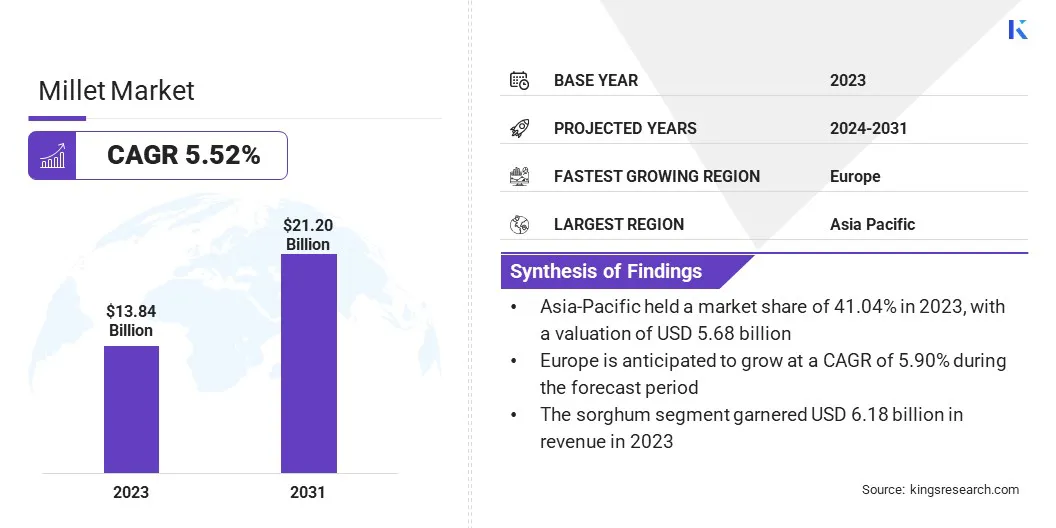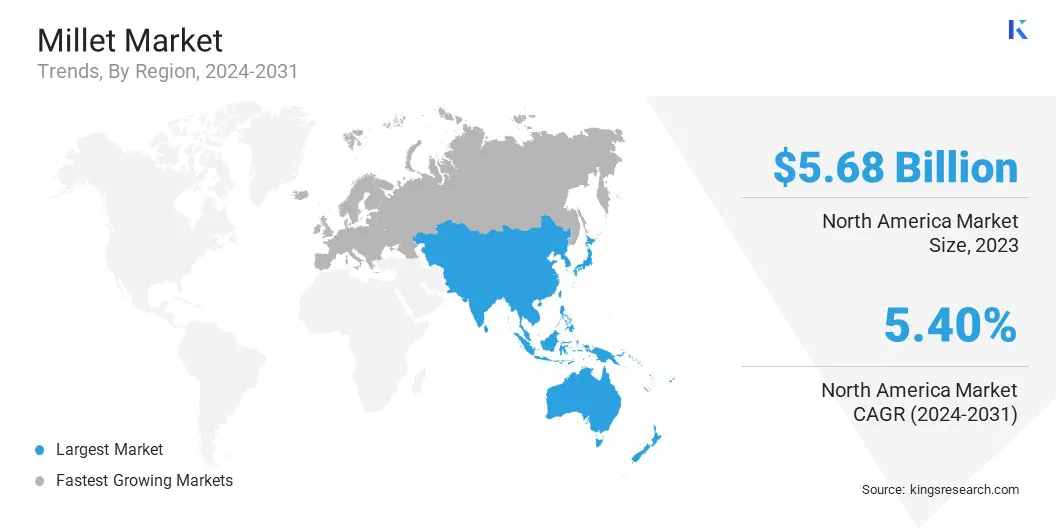Millet Market Size
The Global Millet Market size was valued at USD 13.84 billion in 2023 and is projected to reach USD 21.20 billion by 2031, growing at a CAGR of 5.52% from 2024 to 2031. The robust growth of the market is driven by the rising demand for gluten-free grains, the growing diabetic population, and changing climatic conditions. Millets resilience to climate change and low water requirements make them a sustainable crop. Additionally, growing endorsements by health organizations and inclusion in government dietary guidelines further boost market growth. In the scope of work, the report includes products offered by companies such as ITC Limited, Nestle, Bob's Red Mill Natural Foods, Ancient Golden Mill, Ardent Mills, Nature Mills Private Limited., Jiwa, Bliss Tree, Molino Agostini, Woodland Foods, and others.
Millet production is majorly spread across Asia and Africa, driven by suitable weather conditions, abundant agricultural land, and supporting large-scale cultivation. As demand for sustainable, and nutrient-rich grains grows globally, the Asian and African markets are poised to capitalize on their production capacity and expertise in millet cultivation.
Moreover, the rapidly changing lifestyle and growing health-consciousness are major factors supporting millet market growth. Companies are offering a diverse range of millet-based products to capitalize on the market demand and gain a competitive edge in the millet industry.
Millet refers to a group of small seeded grains belonging to various grasses species. These grains are cultivated for their edible seeds and are commonly used as food sources for humans and animals. Millets encompass different types such as pearl millet, foxtail millet, finger millet, proso millet, barnyard millet, and others, each with its unique characteristics and culinary uses. Regulatory bodies such as the U.S. Department of Agriculture (USDA) and FDA (Food and Drug Administration), FSSAI, European Food Safety Authority (EFSA), and other regional bodies oversee the safety of millet products, ensuring compliance with quality standards and regulations.

Analyst’s Review
The global millet market is poised to experience sizable expansion over the forecast period driven by growing awareness about the nutritional benefits of millet, the resilient nature of the crop, and the rising demand for natural food products. As millets offer various health benefits, multinational food companies, including Britannia, Kellogg, Nestle, and others, are investing significantly in the ready-to-cook and ready-to-eat millet segments to enhance their market positioning.
Manufacturers are strategizing to make millet a mainstream product by enhancing its production, productivity, export, and consumption across the globe. Furthermore, North America and Europe are steadily recognizing the potential benefits of millets and projected to grow substantially in the coming years. With a growing focus on innovation and strategic partnerships, the market is poised to witness continued growth over the forecast period.
Millet Market Growth Factors
The growing demand for gluten-free products is a prominent factor driving global millet market development. The rising prevalence of lifestyle-related disorders such as obesity, celiac diseases, and diabetic conditions has increased the demand for gluten-free products in the past few years. According to the International Diabetes Federation (IDF) 2020-2024 report, approximately 400-600 million adults (20-79 years) are suffering from diabetes.
This rise in obesity and diabetes rates worldwide, is prompting consumers to shift toward healthier dietary choices. Millet is a gluten-free grain that offers various health benefits and is a rich source of carbohydrates, dietary fiber, minerals (such as iron, magnesium, phosphorus, and zinc), protein, antioxidants, and vitamins. These nutrients contribute to a healthy diet and help in managing conditions such as diabetes, obesity, and heart disease, which is fueling product consumption.
Another key prominent factor shaping the growth trajectory of the market is the rising demand for millets in the animal feed and nutrition industry. Millets support animal health by improving feed efficiency and nutrient absorption capability. Different types of millet offer versatility in animal feed formulations and provide nutrition specific solutions to different livestock.
Furthermore, the fodder of these crops is low in oxalic acid and rich in phosphorus, calcium, and minerals that help to manage nutrients in ruminant husbandry. This trend is fueled by the rising awareness regarding the importance of balanced nutrition in the animal feed industry, which is foreseen to augment millet market revenue through the review timeline.
Millet Market Trends
The rising preference for natural and organic food products among consumers is expected to aid millet market expansion over the forecast period. Organic food refers to agricultural products grown and processed without synthetic fertilizers, genetically modified organisms (GMOs), pesticides, or antibiotics. Consumers are actively seeking products that are free from chemicals and artificial additives to maintain a healthy lifestyle. With the rising demand for natural products, manufacturers are strategically focusing on producing organic millet to meet the global demand.
According to the Organic Trade Association (OTA), the sales of organic food in the U.S. were valued at USD 60.00 billion in 2022 and are anticipated to grow at a substantial rate in the forthcoming years. This trend is increasing brand reputation and driving the demand for organic millet-based products across the globe.
Moreover, one of the key trends boosting market growth is the increasing demand for millet in the food and beverage industry. Millets are extensively used in the food processing industry to formulate various products including, bakery & confectionery, snacks and savory, ready-to-cook products, cereals, and more.
Food companies are diversifying product offerings by developing value-added millet products such as biscuits, noodles, cereals, beverages, snacks, and ice creams to cater to the growing global demand for healthy food products. With various health benefits of millets, companies are conducting research and development to enhance their market positioning. For instance, in September 2023, Nestle India launched a millet-based porridge made from pearl millet. The product was developed through comprehensive research and development efforts, with a focus on offering healthy solutions in the millet category.
Segmentation Analysis
The global millet market is segmented based on millet types, form, application, and geography.
By Millet Types
Based on millet types, the market is segmented into finger millet, pearl millet, foxtail millet, little millet, sorghum, and others. The sorghum segment led the market in 2023, reaching a valuation of USD 6.18 billion. This dominance is attributable to the abundant production and versatile applications of sorghum in the food and beverage industry. Sorghum is gaining popularity as a healthier substitute for conventional wheat, rye, and barley. Furthermore, the growing gluten-intolerant consumers across the globe is a pivotal factor set to support segment growth over the forecast period.
By Form
Based on millet form, the market is bifurcated into whole seeds and flour. The millet flour segment accounted for a notable share of 89.39% in 2023 backed by the rising demand for millet flour in African and Asian countries, where millet is a staple crop and is extensively used in daily diets. Furthermore, evolving consumer preferences, growing technological advancements, and rising demand for gluten-free flour in developed regions are boosting segment expansion.
By Application
Based on millet application, the market is segmented into bakery & confectionary, snacks & savory, flakes & cereals, ready-to-cook (noodles & pasta, porridge, and others), and others. The ready-to-cook segment is poised to grow significantly at a CAGR of 5.80% over 2024-2031. Ready-to-cook millet products, including noodles, pasta, porridge, and dosa, are considered an ideal alternative to conventional pasta, noodles, and vermicelli. This has fueled numerous start-ups and multinational companies to enter into millet based ready-to-cook category to gain a competitive edge in the global landscape. Moreover, the United Nations declared 2023 as International Year of Millets to grow awareness regarding the nutritional benefits of millets, which is anticipated to bolster segment growth over the assessment timeline.
Millet Market Regional Analysis
Based on region, the global millet market is classified into North America, Europe, Asia-Pacific, MEA, and Latin America.

The Asia-Pacific Millet Market share stood around 41.04% in 2023 in the global market, with a valuation of USD 5.68 billion. This dominance is attributed to the abundant millet production in India and China. According to the Food and Agriculture Organization (FAO), India and China hold approximately 48% of global millet production, catering to domestic and international demand. Furthermore, supportive government initiatives and policies are foreseen to support market growth in the forthcoming years. For instance, in August 2023, the Indian Ministry of Food Processing Industries (MoFPI) invested USD 10.81 million in the Production Linked Incentive Scheme to foster the production of millet based products across the country.
Europe is projected to grow at a substantial CAGR of 5.90% between 2024 and 2031 due to rising awareness regarding the benefits of millets among consumers. Growing health consciousness, rising demand for clean label food products, and a rapidly growing vegan population are key factors driving the millet market in Europe. Furthermore, Germany, France, and the U.K. are anticipated to exhibit strong demand for millet-based products in the forthcoming years. European companies are strategically focusing on research and development to develop innovative millet-based food products to meet consumer demand, which is foreseen to positively influence the regional market outlook in the upcoming period.
Competitive Landscape
The global millet market report will provide valuable insight with an emphasis on the fragmented nature of the industry. Prominent players are focusing on several key business strategies such as partnerships, mergers and acquisitions, product innovations, and joint ventures to expand their product portfolio and increase their market shares across different regions. Strategic initiatives, including investments in R&D activities, the establishment of new manufacturing facilities, and supply chain optimization, could create new opportunities for market growth.
List of Key Companies in Millet Market
- ITC Limited
- Nestle
- Bob's Red Mill Natural Foods
- Ancient Golden Mill
- Ardent Mills
- Nature Mills Private Limited.
- Jiwa
- Bliss Tree
- Molino Agostini
- Woodland Foods
Key Developments
- May 2023 (Product Launch): ITC Limited added millet cookies under the Sunfeast Farmlite portfolio, which is available in choco-chip and multi-millet variants. Through this launch, the company expanded its millet-based product portfolio.
- April 2023 (Product Launch): Britannia Industries unveiled millet bread under its portfolio. The product is refined flour free and formulated from sorghum, pearl millet, and oats, providing a convenient way for consumers to include millet-based products into their daily diet.
The Global Millet Market is Segmented as
By Millet Types
- Finger Millet
- Pearl Millet
- Foxtail Millet
- Little Millet
- Sorghum
- Others
By Form
By Application
- Bakery & Confectionary
- Snacks & Savory
- Flakes & Cereals
- Ready to Cook (Noodles & Pasta, Porridge and Others)
- Others
By Region
- North America
- Europe
- France
- UK
- Spain
- Germany
- Italy
- Russia
- Rest of Europe
- Asia Pacific
- China
- Japan
- India
- South Korea
- Rest of Asia Pacific
- Middle East & Africa
- GCC
- North Africa
- South Africa
- Rest of the Middle East & Africa
- Latin America
- Brazil
- Argentina
- Rest of Latin America


